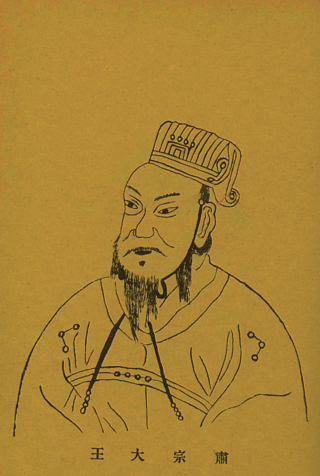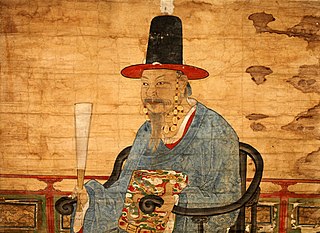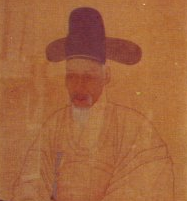
Sukjong,personal name Yi Sun,was the 19th monarch of the Joseon dynasty of Korea. A skilled legislator,he caused multiple changes in political power throughout his reign,by switching among the Namin (Southerners),Seoin (Westerners),Soron and Noron political factions.

Seonjo,personal name Yi Yeon,was the 14th monarch of the Joseon dynasty of Korea. He was known for promoting Confucianism and attempting reforms at the beginning of his reign. However,he later gained infamy from the political discord and his incompetent leadership during the Japanese invasions of Korea.

Jo Gwang-jo,also often called by his art name Jeongam (정암),was a Korean Neo-Confucian scholar who pursued radical reforms during the reign of Jungjong of Joseon in the early 16th century.
Gyeongjong,personal name Yi Yun,was the 20th monarch of the Joseon dynasty of Korea. He was the eldest son of King Sukjong by his concubine,Royal Noble Consort Hui of the Indong Jang clan.

The Bungdang refers to political factionalism that was characteristic of middle and late Joseon. Throughout the dynasty,various regional and ideological factions struggled for dominance in the political system.
Queen Jeongsun,of the Gyeongju Kim clan,was a posthumous name bestowed to the wife and second queen consort of Yi Geum,King Yeongjo,the 21st Joseon monarch. She was queen consort of Joseon from 1759 until her husband's death in 1776,after which she was honoured as Queen Dowager Yesun (예순왕대비) during the reign of her step-grandson Yi San,King Jeongjo and as Grand Queen Dowager Yesun (예순대왕대비) during the reign of her step great-grandson Yi Gong,King Sunjo.
Literati purges is a translation of the Korean term sahwa,whose literal meaning is "scholars' calamity." It refers to a series of political purges in the late 15th and the 16th centuries in which Sarim scholars suffered persecution at the hands of their political rivals.
The rebellion of Jeong Yeo-rip in 1589,known in Korean as the Gichuk oksa,was one of the bloodiest political purges in Korea's Joseon Dynasty. Its scale was greater than all four of the notorious literati purges combined. At that time Joseon politics was dominated by conflict between Eastern and Western factions. Neo-Confucian scholar and Easterner,Jeong Yeo-rip was accused of high treason,after which as many as 1,000 Easterners were killed or exiled.

Yi Sanhae was a Korean politician,scholar,writer and poet of the Joseon period who came from the Hansan Yi clan. He served as the Chief State Councilor of Joseon from 1590 to 1592 and 1600. Yi was a member of the political faction the Easterners and when this split into the Northerners and Southerners,Yi became leader of the Northerners faction.
Queen Inhyeon,of the Yeoheung Min clan,was the second wife of King Sukjong,the 19th Joseon monarch. She was queen of Joseon from 1681 until her deposition in 1688,and from her reinstatement in 1694 until her death in 1701. She is one of the best known queens in Korean history and her life has been portrayed in many historical dramas.

Royal Noble Consort Hui of the Indong Jang clan,personal name Jang Ok-jeong,was an infamous consort of Sukjong of Joseon and the mother of King Gyeongjong. She was queen of Joseon from 1690 until her deposition in 1694.
Queen Inwon,of the Gyeongju Kim clan,was a posthumous name bestowed to the wife and fourth queen consort of Yi Sun,King Sukjong,the 19th Joseon monarch. She was queen consort of Joseon from 1702 until her husband's death in 1720. She was honoured as Queen Dowager Hyesun (Korean: 혜순왕대비) during the reign of her step-son Yi Yun,King Gyeongjong,and later as Grand Queen Dowager Hyesun (Korean: 혜순대왕대비) during the reign of her adoptive son,Yi Geum,King Yeongjo.
Queen Seonui of the Hamjong Eo clan,was the second wife of Yi Yun,King Gyeongjong,the 20th Joseon monarch. She was Queen of Joseon from 1720 until her husband's death in 1724,after which she was honoured as Royal Queen Dowager Gyeongsun (경순왕대비).

Yun Du-su was a Korean scholar-official of the Joseon period. He was a politician,poet,writer,scholar,and part of the Yi Hwang school among Westerners faction. He served as Chief State Councillor during the reign of King Seonjo.

The Easterners were a political faction of the Joseon dynasty. This faction appeared during the reign of Seonjo of Joseon in sixteenth-century Korea,in 1575. Originating from friends of Gim Hyowon,they soon encompassed most of the disciples of Jo Sik and Yi Hwang,conflicting with Yi I and his followers,who formed the core of the Westerners. Though emerging as the dominant faction in the 1580s,it nearly collapsed at the suicide of Jeong Yeo-rip and the succeeding bloodshed in 1589. After Westerner Jeong Cheol was exiled for attempting to make Prince Gwanghae the Crown Prince,the Easterners divided into Northerners and Southerners.

The Westerners was a political faction that dominated Korea in the 17th century. In 1575,the Sarim split into the Easterners and Westerners. The Westerners remained the main contender of the Easterners in the Seonjo age.
The Soron was a political faction of the Joseon Dynasty. The faction was consisted of the opponents of Song Siyeol after the split of the Westerners. Their leader was Yun Jeung,who died in 1714. They were favored by King Gyeongjong,who died in October 1724. In December 1728,King Yeongjo was accused of poisoning King Gyeongjong. This led to the Musin Revolt in Jeolla Province. The rebels enjoyed support from people in Gyeonggi Province and Chungcheong Province.
The Noron were a political faction of the Joseon Dynasty in Korea. They consisted of the supporters of Song Siyeol after the split of the Westerners. The Noron suffered setbacks with regent Kim Seok-ju's death in 1684 and Song's execution in 1689. In 1701,Queen Inhyeon,who favored the Noron,died. They were favored by King Yeongjo,who came to the throne in 1724.
The Southerners were a political faction of the Joseon Dynasty. The faction was created after the split of the Easterners in 1591 by Yi Sanhae's opponents. Its leader was Ryu Seong-ryong,who died in 1607. Leader Heo Mok was Left Prime Minister from 1675 to 1678. Leader Yun Hyu was executed in 1680. They supported Jang Huibin,queen consort of Sukjong of Joseon from 1688 to 1694. The faction continued to exist until the 18th century.
Hungu was a political faction of the Joseon Dynasty in the 15th and 16th centuries. It formed in 1455 under Sejo of Joseon. After the death of Sejo and ascension of Seongjong of Joseon,the rival faction Sarim gained power and influence. The Hungu retaliated under the reign of Yeonsangun in two violent purges of Sarim members. After Yeonsangun's overthrow by pro-Sarim Jungjong and his minister Jo Gwang-jo,Hungu engineered a third purge that resulted in Jo's death. Hungu wielded power through the rest of Jungjong's reign and into the reign of Myeongjong of Joseon. In 1567,with the ascension of Seonjo of Joseon to the throne,the influence of Hungu permanently ended in favor of Sarim.







